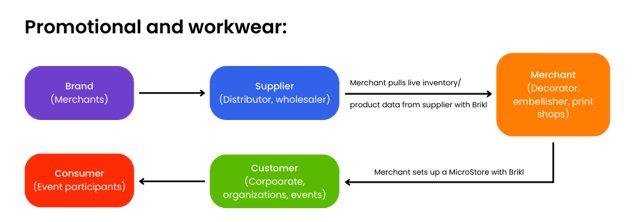In the custom and promotional industry there are some distinct differences between suppliers, merchants, and customers that you should know.
The difference between the three is important in ensuring you’re accurately envisioning the end user, as these are not interchangeable.
The way the market is organized changes depending on whether you’re looking at a custom business or a promotional company.
Sportswear and team wear
Take custom sportswear and teamwear, as an example. As you can see from the diagram below, there are three separate layers to take into account.

Brikl refers to the companies that work directly with us as our merchants. They set up a team store - or MicroStore - with us and sell their products to their customers.
As you can see from the flow chart above, a custom business’ target customers are teams, clubs, organizations and events primarily. Then the final end user, or consumer, is the team member.
We don’t talk about suppliers when we talk about custom products because, as the flow diagram shows, the merchant, supplier and brand are a bundle - they’re all in one.
Promotion wear and workwear
In contrast, promotion and workwear businesses embellish blanks. That's why merchants in this industry are also defined as decorators, embellishers, or print shops.

The supplier in this flow is the distributor and wholesaler are distinctly defined.
The promotion product merchant in this example would pull live inventory from the supplier. The merchant would then set up MicroStores to actively promote and sell their products to their customers: corporate organizations or events.
Finally, embellishments would be carried out either in-house or the responsibility would be outsourced, and the embellished products shipped to the customer.
MicroStores are a game-changer for this market in the traditional sense - they save time and automate the manual. But they also provide the critical ability of enhanced visibility. Instead of asking their customers what they need (which may or may not be available from the supplier), they can just pull live inventory and product data directly from the supplier.
